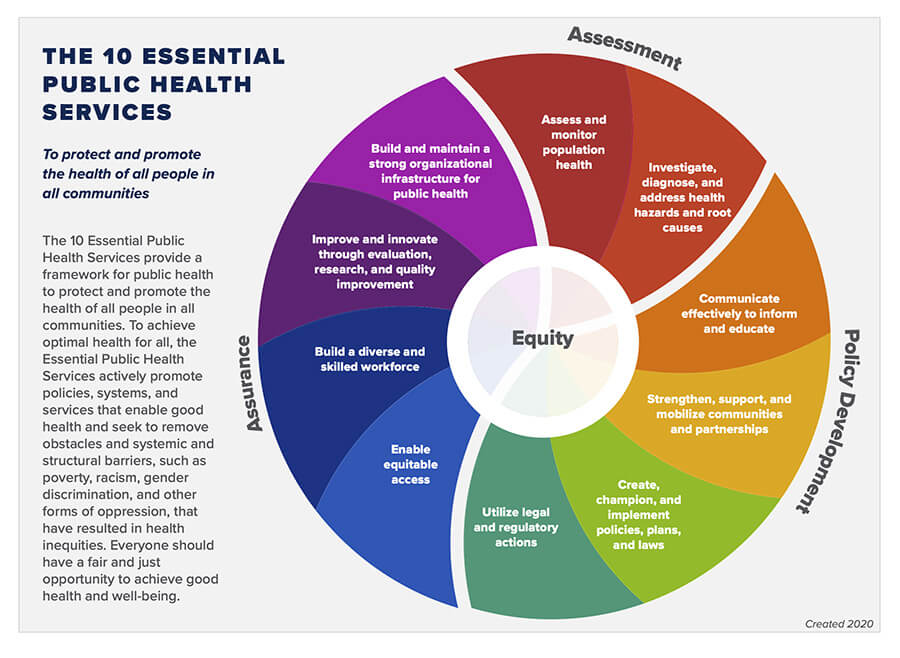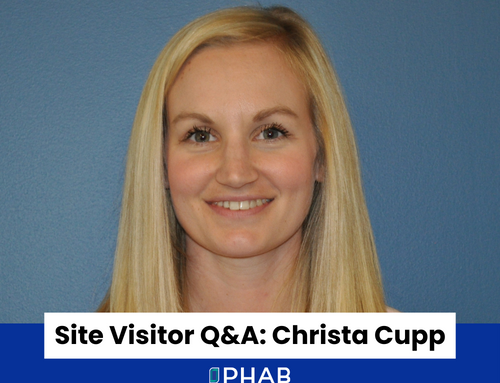On September 9, 2020 a revised version of the 10 Essential Public Health Services (10 EPHS) was unveiled to public health professionals and key stakeholders across the country during a virtual launch event. Developed with tremendous input from the field, the 10 EPHS are intended to reflect current and future public health practice. Throughout Task Force discussions, it was clear that equity is perhaps more important now than ever before in public health. This was confirmed during the public vetting period and led to the inclusion of an equity statement and revolving the framework, in practice and in the graphic, around equity.
Since their inception in 1994, the original 10 EPHS have provided roadmap of goals for carrying out the mission of public health in communities across the United States. Now, over 25 years later, the framework continues to serve as a guiding document, created by the field and for the field.
To embed the framework in daily work, public health professionals shared how they use the 10 EPHS and how you can too.

1. Communication – the Essential Public Health Services provide a common language to discuss public health work internally, with external stakeholders, and with the community at large
”We’ve used the 10 EPHS to explain what public health is all about, to both community members and other members of the public health system, in presentations, annual reports, etc.” – Anne Goone, Marietta/Belpre Health Department, Health Commissioner
2. Structure – the Essential Public Health Services serve as a basis for organizing resources to effectively and efficiently protect and promote the health of all people in all communities
”The Original 10 EPHS has impacted my work by streamlining my attention. There are so many needs in public health, the ability to focus on the 10 EPHS provides a tool to narrow my focus and share with others who may have interests that cause mission creep. The original 10 EPHS allow me to ‘stay the course’.” – Dawn Groth, State of Alaska, Public Health, RN, BSN, Public Health Specialist; Breastfeeding and Physical Activity
3. Preparing for the Workforce – inform and educate, an Essential Public Health Service, is foundational in the work of public health professionals and can be modeled at every level of public health learning
“Developing public health courses driven by the work of the 10EPHS has provided students an opportunity to further comprehend public health. Master of Public Health students feel a connection to their degree by learning about the 10EPHS.” – Dulce Ruelas, Grand Canyon University, Assistant Professor
4. Reporting – use the Essential Public Health Services as a guide to how to organize and report on public health work and to help identify the role of public health practitioners and partners
“The original 10 EPHS provided the framework for overhauling my Department’s annual report and resulted in a much more reader-friendly and accepted document.” – Kevin Sumner, Middle-Brook Regional Health Commission, Health Officer/Director
5. Strategic Engagement – use the Essential Public Health Services to understand the role of various agencies in community health improvement planning the Essential Public Health Services
“I have 25+ years of government PH experience at federal (CDC), state (GA), and local levels (Philadelphia), plus I’ve been a faculty member at 2 schools… The 10 essential functions represent an essential organizing principle for understanding what public health agencies do and how they work with a broad mix of partners to protect and promote public health.” – James Buehler, DSPH, Drexel University, Clinical Professor and Interim Chair, Health Management and Policy
View the complete 10 Essential Public Health Services and additional resources in this free toolkit. To share how you use the 10 EPHS, please email [email protected].





